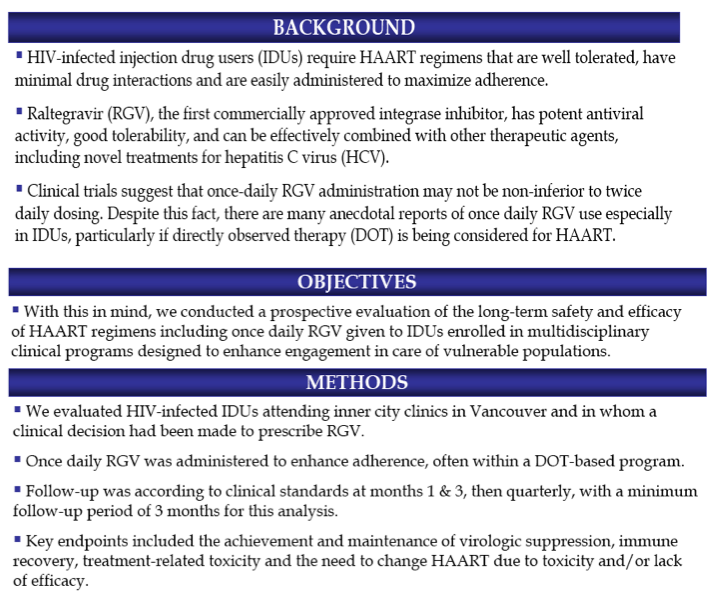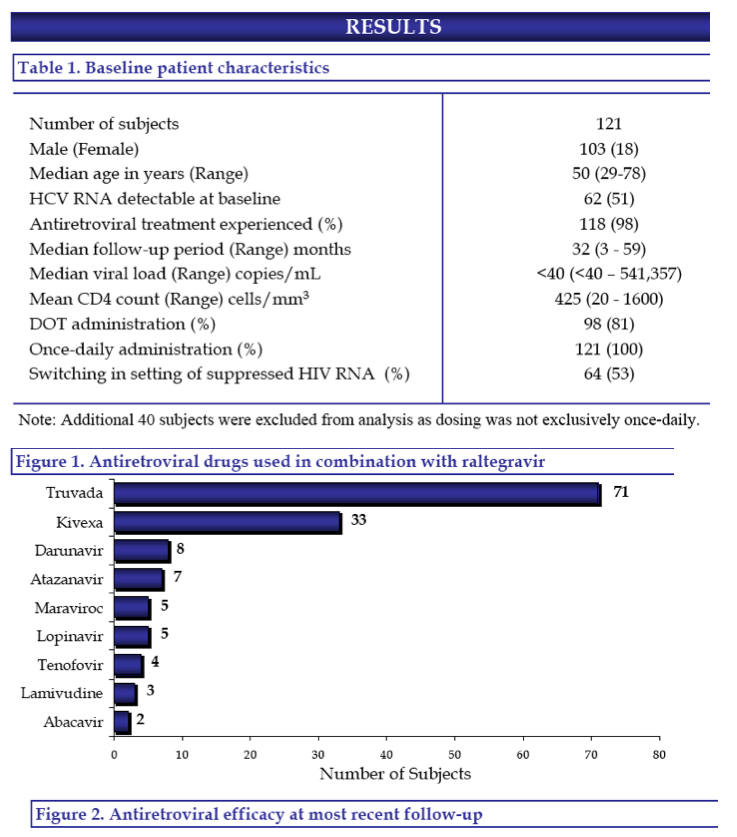 |
 |
 |
| |
Safety and Efficacy of Once Daily Raltegravir to Enhance
Adherence and Efficacy of HAART in Vulnerable HIV-Infected Patients
|
| |
| |
Reported by Jules Levin
52nd ICAAC Sept 9-12 2012 SF
Kris Stewart1, Harout Tossonian2, Osamah Alenezi2, Leala Wong2, Brian Conway B2,3
1Univeristy of Saskatchewan, Saskatoon, Canada ; 2University of British Columbia, Vancouver, Canada;
3Pender Community Health Centre, Vancouver Coastal Health, Vancouver, Canada

Program Abstract
Background: Injection drug users (IDUs) require therapeutic regimens that are well tolerated, minimize drug interactions and are easily administered to maximize adherence. Raltegravir (RGV) has few side effects and can be combined with other therapeutic agents, including novel treatments for HCV. However, clinical trials have shown that once-daily RGV administration may be inferior to twice daily dosing. This limits its use in IDUs, especially those in directly observed treatment (DOT) algorithms. However, once daily RGV is used in clinical practice in such settings. We conducted a prospective evaluation of the long-term safety and efficacy of HAART regimens including once daily RGV given to IDUs enrolled in multidisciplinary clinical programs.
Methods: We evaluated HIV-infected IDUs attending inner city clinics in Vancouver treated with once daily RGV containing regimens, often within a DOT program. Key endpoints included the achievement and maintenance of virologic suppression, immune recovery, treatment-related toxicity and the need to change HAART due to toxicity and/or lack of efficacy.
Results: Of 150 patients (88% male), DOT was the mode of administration in 85% of cases. Median CD4 cell count and HIV plasma viral load (pvl) at baseline were 350 cells/mm3 and 28 500 copies/mL plasma. Over a median follow-up period of 12 (6-18) months, 80% had maximal virologic suppression. CD4 cell counts increased by a median 150 cells/mm3. Median adherence therapy exceeded 90%. Virologic breakthrough (pvl > 400 copies/mL) occurred in 10% of cases. Resuppression was achieved in all cases over the subsequent 3 months. There were no cases of emergent RGV resistance. There were no cases of treatment-emergent RGV toxicity leading to drug discontinuation.
Conclusions: RGV was well tolerated in an IDU population, with a high degree of adherence. Once daily administration was highly effective, with minimal virologic breakthrough and no drug resistance. Once-daily RGV can be an important component of HAART in this (and other) populations when a safe and effective medication is required and twice daily dosing is not feasible.



|
| |
|
 |
 |
|
|